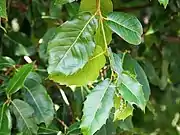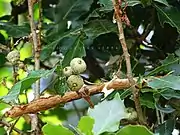| Quercus floribunda | |
|---|---|
 | |
| Quercus floribunda growth form | |
| Scientific classification | |
| Kingdom: | Plantae |
| Clade: | Tracheophytes |
| Clade: | Angiosperms |
| Clade: | Eudicots |
| Clade: | Rosids |
| Order: | Fagales |
| Family: | Fagaceae |
| Genus: | Quercus |
| Subgenus: | Quercus subg. Cerris |
| Section: | Quercus sect. Ilex |
| Species: | Q. floribunda |
| Binomial name | |
| Quercus floribunda | |
| Synonyms[3] | |
| |
Quercus floribunda, called the Moru oak or Mohru oak, Tilonj oak and green oak, is a species of oak native to Afghanistan, Pakistan, India's western Himalaya, and Nepal,[3] typically found from 2,000 to 3,000 metres (6,600 to 9,800 feet) above sea level. It is in the subgenus Cerris, section Ilex.[4] An evergreen tree with a dense crown reaching 30 m (98 ft), it is an important fuelwood and fodder species.[5]
 young leaves are red
young leaves are red variety in leaf shape
variety in leaf shape acorns
acorns pollarded for charcoal or fodder production
pollarded for charcoal or fodder production
References
- ↑ Carrero, C.; Strijk, J.S. (2020). "Quercus floribunda". IUCN Red List of Threatened Species. 2020: e.T78917469A78917485. doi:10.2305/IUCN.UK.2020-3.RLTS.T78917469A78917485.en. Retrieved 13 November 2022.
- ↑ Chênes, Atlas 2: 131 (1935)
- 1 2 "Quercus floribunda Lindl. ex A.Camus". Plants of the World Online. Board of Trustees of the Royal Botanic Gardens, Kew. 2017. Retrieved 15 October 2020.
- ↑ Denk, Thomas; Grimm, Guido W.; Manos, Paul S.; Deng, Min & Hipp, Andrew L. (2017). "Appendix 2.1: An updated infrageneric classification of the oaks" (xls). figshare. Retrieved 2023-02-18.
- ↑ Okia, Dr. Clement A. (25 April 2012). Global Perspectives on Sustainable Forest Management. ISBN 9789535105695.
This article is issued from Wikipedia. The text is licensed under Creative Commons - Attribution - Sharealike. Additional terms may apply for the media files.
